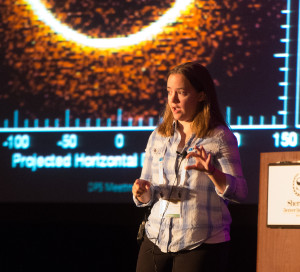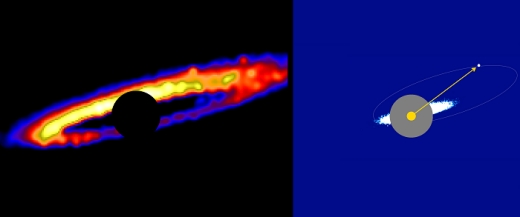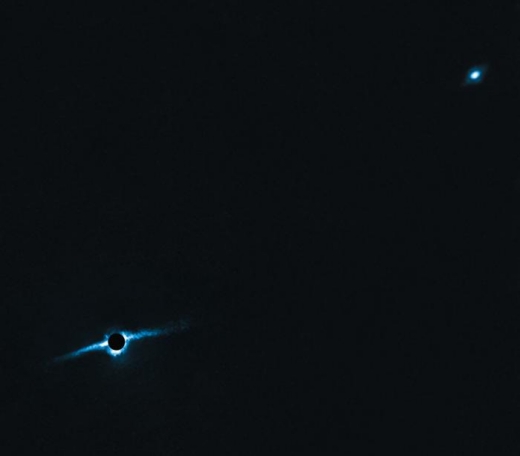A massive young planet on the borderline between gas giant and brown dwarf is telling us a bit more about planet formation in general, and circumstellar disk dynamics in particular. Known as HD 106906b, the world is 11 times the mass of Jupiter and no more than 13 million years old. Its position 650 AU from its star creates an orbit that takes 1500 years to complete.
The host HD 106906, about 300 light years from Earth, is an F5-class star in the constellation Crux, the southern constellation dominated by the asterism we call the Southern Cross.

What we find here is a debris disk that is non-circular, its shape evidently explained by the presence, well outside the disk, of HD 106906b, whose orbit is elliptical. Observations through the Gemini Planet Imager, the Hubble Space Telescope and ESO’s SPHERE (Spectro-Polarimetric High-contrast Exoplanet REsearch instrument) show that we are viewing the disk nearly edge-on. The inner region appears cleared of small dust grains.
Working with these observations, a team led by Erika Nesvold, a postdoctoral fellow at the Carnegie Institution for Science, used a software tool she created called Superparticle-Method Algorithm for Collisions in Kuiper belts and debris disks (SMACK) to model the planet’s orbital path and assess its effects on the circumstellar disk.
Image: Erika Nesvold, creator of the software that made possible the new analysis of HD 106906b.
The disk, an analog of our own Kuiper Belt, is much closer to the star on one side than on the other, producing a stronger infrared signature on the warmer side. The model accurately reproduces the shape of the disk as a result of the perturbations caused by this distant planet. The team’s analysis shows that the planet must have formed outside the disk; otherwise, the disk would have been perturbed in an entirely different manner. From the paper:
Constraining the orbit of HD 106906b could have implications for its formation scenario. Prior to the publication of resolved images of the disk, it was suggested (using N-body simulations) that the companion formed interior to the disk and was scattered onto a highly eccentric orbit (Jílková & Portegies Zwart 2015). This study concluded that the disk can survive perturbations by a companion with an apocenter distance of 650 au and a pericenter distance interior to the disk if the companion’s inclination is ? 10°. However, this resulted in a significantly vertically perturbed disk by 10 Myr, regardless of the companion’s inclination. Our simulations indicate that a companion with an orbit completely exterior to the disk can reproduce the observed asymmetries without vertically extending the disk, supporting the scenario in which the companion formed in situ.

Image: Two images of the HD 106906 stellar system created by Erika Nesvold and her team’s simulation. The left panel shows a zoomed-in image of the ring of leftover rocky and icy planet-forming material that is rotating around the star. (The star is masked by the black circle.) The different hues represent gradients of brightness in the disk material. (Yellow is the brightest and blue the dimmest.). The right panel shows a farther-out view of the simulated system. The star is represented by the yellow circle with an arrow pointing to the exoplanet, HD 106906b. Nesvold’s team demonstrated that the exoplanet is shaping the structure of the debris disk, which is shown by the white and blue dots encircling the star. Credit: Erika Nesvold/Carnegie Institution for Science.
SMACK is able to re-create the shape of the disk without the addition of any planets within the disk itself, although the question of possible planets there remains open. The paper acknowledges that while HD 106906b can account for the disk’s shape, there are alternative mechanisms, including a planet within the debris disk, that could also force its eccentricity. Tightening up the parameters of HD 106906b’s orbit should help to resolve the question.

Image: This is an actual observation of HD 106906 taken by the European Southern Observatory’s planet-finding tool SPHERE. The star is blacked out by a circle (which masks its glare from blinding the instrument) and the debris disk can be seen in the lower left. In the upper right is the exoplanet, 106906b. The simulation created by Erika Nesvold and her team accurately recreated the observed characteristics of the disk: the disk is brighter on its eastern (left) side, and oriented about 20 degrees clockwise from the planet’s position on the sky. Credit: ESO and A.M. Lagrange of Université Grenoble Alpes.
Modeling tools like SMACK are going to be turned to other young system disks as we work to understand planetary evolution. After all, we’re seeing the process here in its infancy. “In our solar system, we’ve had billions of years of evolution,” said Michael Fitzgerald, UCLA associate professor of physics and astronomy, and a co-author on the study. “We’re seeing this young system revealed to us before it has had a chance to dynamically mature.”
The paper points out that previously undetected planets may be investigated by modeling the asymmetries in such disks. We do know that systems like this, with a large, exterior perturber of some kind, are not uncommon. Some 25 percent of known debris disks exist, for example, in binary or triple star systems. Understanding disk perturbations, whether they are caused by planets within the disk or outside of it, may point us toward the worlds that cause them.
The paper is Nesvold, Naoz & Fitzgerald, “HD 106906: A Case Study for External Perturbations of a Debris Disk,” Astrophysical Journal Letters Vol. 837, No. 1 (1 March 2017). Abstract / preprint.



Isn’t just imaging the planet fairly impressive?
Off-centered debris disks as a result of a planet’s gravitational influence. Another unexpected situation suitable for scifi world building.
Is the image above where the star is blacked out the first genuine photograph of an exoplanet? Or have there been other photos where lucky timing allowed the star to be blacked out by some other object so that the planet could be seen?
List of imaged exoplanets here:
https://en.m.wikipedia.org/wiki/List_of_directly_imaged_exoplanets
Another question: Is the circle that blacks out the star in the image above part of the telescope structure? Or is there a real astronomical object blocking the star’s glare?
The SPHERE facility at the Very Large Telescope uses a coronagraph to block out the light of the central star, to make observation of the planet possible. This is part of the procedure, and definitely not an astronomical object between us and the star.
So Paul,
Just doing some back of the envelope math, if we can photograph a planet 11 times bigger than Jupiter at a distance of 300 light years, could the SPHERE tool photograph Proxima b, which is only 1.3 times the size of earth, but 70 times closer than HD 106906? Or is Proxima b too close to its star for the coronagraph to work?
A good question for the SPHERE team, who I suspect would tell us that Proxima b is both too small and too cool to be imaged, which is why a transit would be so helpful if one existed.
Does this method also work for older debris disks? It would be great if we could deduce a giant planet in a wide (e.g. Jupiter like) orbit from the debris disk, without having to wait the many years of a few orbital periods (such as in the RV method).
Slightly off-topic, but also pertaining to proto-planetary debris disks:
https://www.sciencedaily.com/releases/2017/03/170322110950.htm
“Stars don’t have to be massive to evaporate material from around nearby stars and affect their ability to form planets, a new study suggests”.
What consequences, if any, does this have for planetary system formation around binary stars? I mean, we know that planetary systems around binary stars are quite common, how is this possible with massive evaporation?